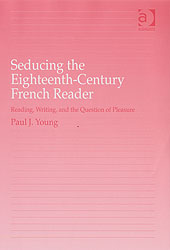
P. J. Young, Seducing the Eighteenth-Century French Reader Reading, Writing, and the Question of Pleasure
Paul J. Young, Seducing the Eighteenth-Century French Reader Reading, Writing, and the Question of Pleasure, Ashgate, 2008, 174p.
Isbn (ean13): 978-0-7546-6417-8
Présentationde l'éditeur:
As he demonstrates that narratives ofseduction function as a master plot for French literature in the eighteenthcentury, Paul Young argues that the prevalence of this trope was a reaction toa dominant cultural discourse that coded the novel and the new practice of solitary reading as dangerous, seductive practices. Situating his study in thecontext of paintings, educational manuals, and criticism that caution againstthe act of reading, Young considers both canonical and lesser-known works byauthors that include Rousseau, Sade, Bastide, Laclos, Crébillon fils, and thewriters of two widely read libertine novels. How these authors responded to acultural climate that viewed literature, and especially the novel, asseductive, sheds light on the perils and pleasures of authorship, the ways inwhich texts interact with the larger cultural discourse, and whateighteenth-century texts tell us about the dangers of reading or writing. Ultimately,Young argues, the seduction not in the text, but by the text raises questionsabout the nature of pleasure in eighteenth-century French literature andculture.
Table des matières:
Introduction; Reading, writing, and seduction; Moving beyond pleasure:writing (in) the libertine novel; Looking inside: the ambiguous interiors of LaPetite Maison; Seducing the reader? Perversion and disruption in La NouvelleHéloïse; When excess isn't enough: secrets and silences in the Sadean text;Conclusion; Bibliography; Index.
Paul J. Young is assistantprofessor of French at Georgetown University, USA